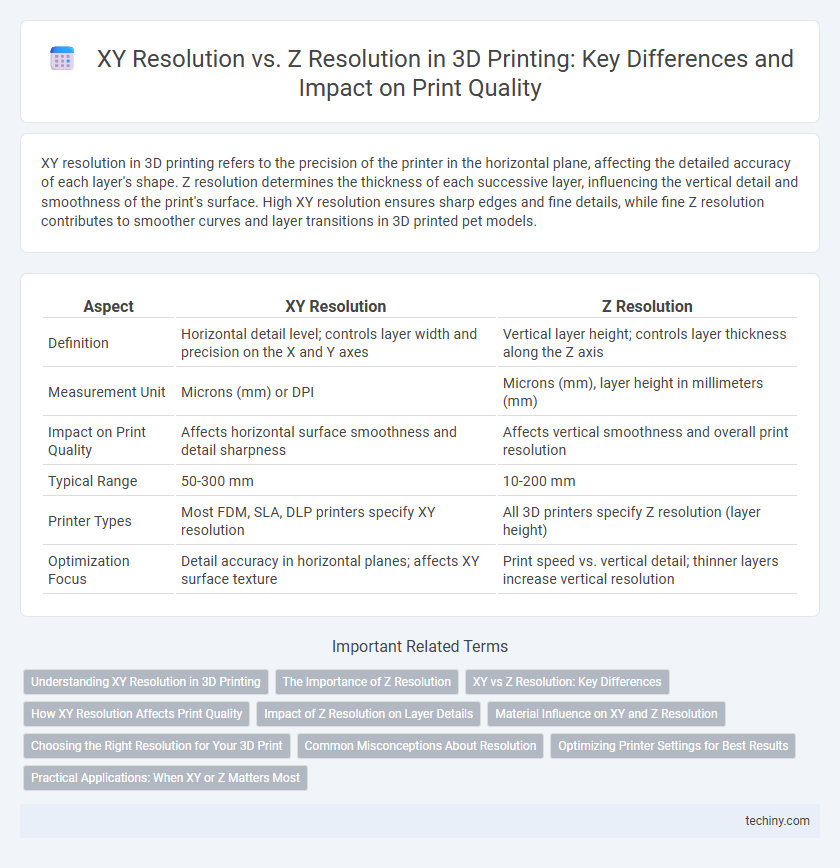XY resolution in 3D printing refers to the precision of the printer in the horizontal plane, affecting the detailed accuracy of each layer's shape. Z resolution determines the thickness of each successive layer, influencing the vertical detail and smoothness of the print's surface. High XY resolution ensures sharp edges and fine details, while fine Z resolution contributes to smoother curves and layer transitions in 3D printed pet models.
Table of Comparison
| Aspect | XY Resolution | Z Resolution |
|---|---|---|
| Definition | Horizontal detail level; controls layer width and precision on the X and Y axes | Vertical layer height; controls layer thickness along the Z axis |
| Measurement Unit | Microns (mm) or DPI | Microns (mm), layer height in millimeters (mm) |
| Impact on Print Quality | Affects horizontal surface smoothness and detail sharpness | Affects vertical smoothness and overall print resolution |
| Typical Range | 50-300 mm | 10-200 mm |
| Printer Types | Most FDM, SLA, DLP printers specify XY resolution | All 3D printers specify Z resolution (layer height) |
| Optimization Focus | Detail accuracy in horizontal planes; affects XY surface texture | Print speed vs. vertical detail; thinner layers increase vertical resolution |
Understanding XY Resolution in 3D Printing
XY resolution in 3D printing refers to the smallest movement or detail that the printer can achieve in the horizontal plane, directly influencing the precision and detail of the printed object's surface features. This resolution depends on factors such as the nozzle diameter, stepper motor precision, and the mechanics of the printer's XY gantry system. Higher XY resolution enables finer details and smoother curves, making it essential for applications requiring intricate designs and accurate dimensional fidelity.
The Importance of Z Resolution
Z resolution in 3D printing determines layer thickness and directly affects surface smoothness and detail accuracy, making it crucial for high-precision prints. While XY resolution controls the horizontal detail and accuracy, Z resolution dictates the vertical fidelity and overall vertical texture quality. Optimizing Z layer height enables finer details and reduces visible layer lines, essential for producing intricate models and functional prototypes.
XY vs Z Resolution: Key Differences
XY resolution in 3D printing refers to the horizontal precision determined by the printer's stepper motors and nozzle size, significantly influencing the detail and smoothness of the print's surface. Z resolution, however, governs the vertical layer thickness, affecting the print's height accuracy and layer adhesion. The primary difference lies in how XY resolution controls lateral detail while Z resolution impacts vertical smoothness and structural integrity.
How XY Resolution Affects Print Quality
XY resolution determines the horizontal detail and sharpness of a 3D printed object by controlling the precision of the printer's nozzle or laser movement across the print bed. Higher XY resolution enables finer surface textures and intricate patterns, resulting in smoother curves and more accurate dimensional features. Poor XY resolution causes visible layer lines and rough edges, significantly reducing overall print quality regardless of Z resolution settings.
Impact of Z Resolution on Layer Details
Z resolution in 3D printing directly impacts the layer height, determining the vertical detail and surface smoothness of the final model. Higher Z resolution allows for thinner layers, resulting in finer details and reduced visible layer lines compared to the XY resolution which controls horizontal accuracy. Optimizing Z resolution is crucial for applications requiring intricate textures and improved mechanical properties in the vertical axis.
Material Influence on XY and Z Resolution
Material properties significantly impact both XY and Z resolution in 3D printing, influencing layer adhesion and surface finish. Viscosity and curing behavior of resins or thermoplastics affect XY resolution by determining filament flow precision and detail sharpness. In contrast, Z resolution depends on layer thickness capabilities and material shrinkage during solidification, with some materials allowing finer vertical layering for enhanced vertical accuracy.
Choosing the Right Resolution for Your 3D Print
XY resolution determines the horizontal detail and precision of a 3D print, crucial for capturing fine surface textures and intricate patterns. Z resolution controls layer thickness, affecting vertical smoothness and overall print height accuracy. Selecting the appropriate balance between higher XY resolution and finer Z resolution depends on the desired detail, print speed, and material compatibility to achieve optimal print quality.
Common Misconceptions About Resolution
XY resolution in 3D printing refers to the smallest movement the printer can make on the horizontal plane, typically measured in microns, while Z resolution indicates the layer height or vertical precision. A common misconception is that higher XY resolution alone guarantees greater print detail, but the Z resolution critically influences surface smoothness and fine vertical details. Truly optimized 3D prints require balanced XY and Z resolutions tailored to the specific technology and material used.
Optimizing Printer Settings for Best Results
Optimizing printer settings for best results in 3D printing involves balancing XY resolution and Z resolution to achieve detailed and accurate prints. High XY resolution enhances the horizontal detail by controlling the laser or nozzle precision, while fine Z resolution ensures smooth vertical layer transitions, minimizing layer lines and improving surface finish. Adjustments in layer height, printing speed, and exposure time are crucial to harmonize both resolutions for optimal print quality and structural integrity.
Practical Applications: When XY or Z Matters Most
In 3D printing, XY resolution determines the horizontal detail and accuracy, which is critical for intricate surface features and fine textures in models like jewelry or dental implants. Z resolution controls the vertical layer thickness, significantly impacting the smoothness and strength of parts, especially in functional prototypes and aerodynamic components. Selecting the appropriate resolution depends on application needs: high XY resolution excels in detailed aesthetics, while high Z resolution is essential for structural integrity and layer adhesion.
XY Resolution vs Z Resolution Infographic

 techiny.com
techiny.com